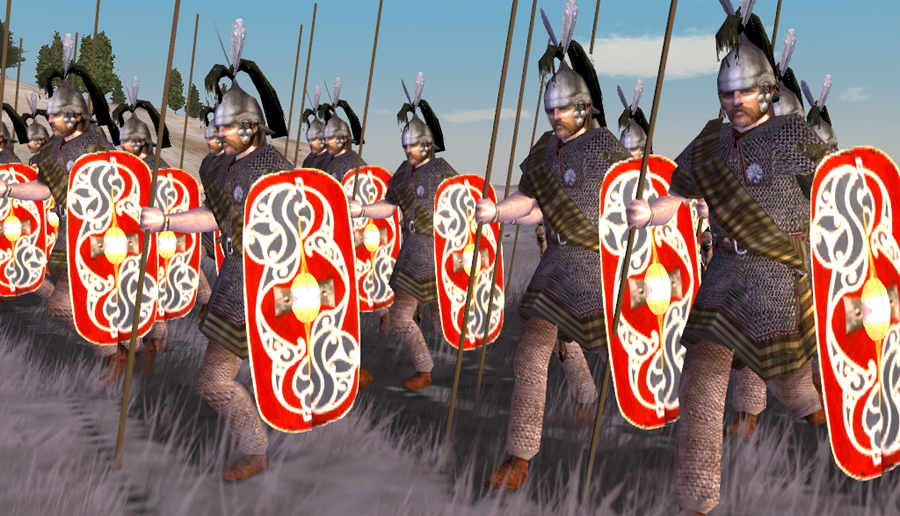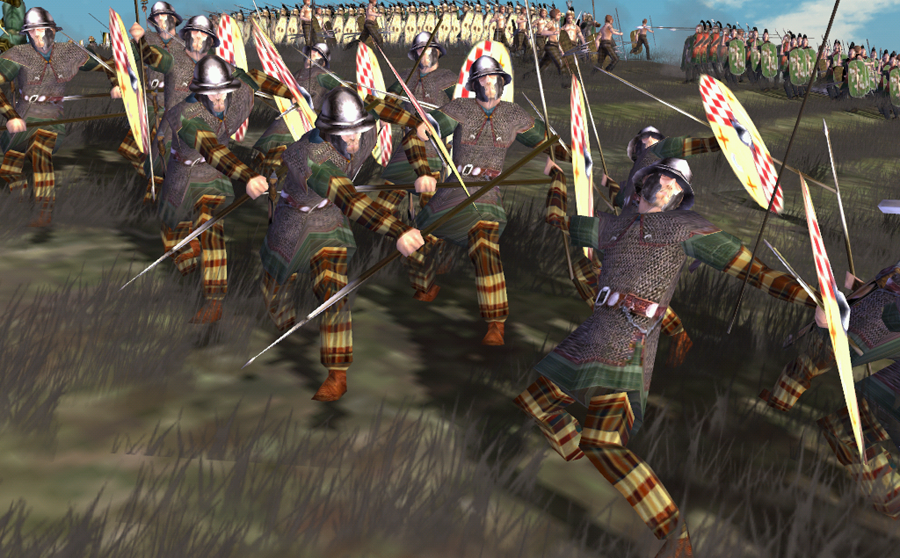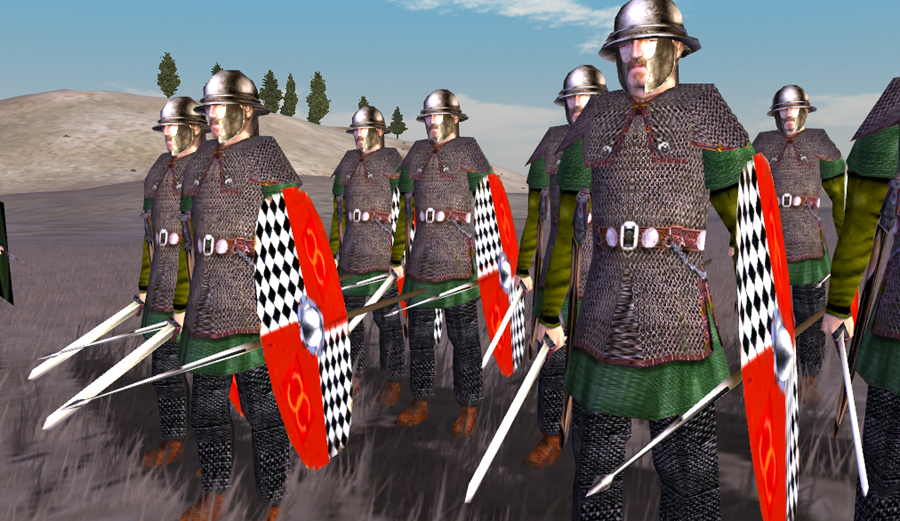
This is probably the most anecdotic and difficult type of ancient warrior to be depicted, even more foggy than the Kardaka; But the Gallic world "Soldurii" passed onto ancient frankish, now French, gave "soldat" exported in English from 1066 as "soldier". No less. This world however was perhaps not "gallic" as much as it was from the Aquitanni, ancient inhabitants of the SW corner of gaul, between the foothills of the Pyrhenees and nearby Iberians, and the gulf of Biscay. Local archaeologists insist to this day that these populations were not comparable to other gauls, although sharing many similarities. They kept their indigineous language which related to Basque and other primitove forms of Iberian. There is some clues they descended from the ancient inhabitants of this corner of Europe, before the arrival of the Celts, as far as 400 BC. Even Caesar cleary draw a line between these peoples, which related to the trans-iberian Iacetani and Vascones. However, "Soldurii" (sing. soldūrius) was a latinization of an existing Aquitanni word (solduros). The general definition was these were retainers or vassals of a chieftain: “devoti”. This is somewhat not assimilated to the Ambact, "servant".
Origin in text
The best known mention is still Julius Caesar "De bello Gallico" in which he depicted a battle scene:"... And while the attention of our men is engaged in that matter, in another part Adcantuannus, who held the chief command, with 600 devoted followers whom they call soldurii (the conditions of whose association are these, - that they enjoy all the conveniences of life with those to whose friendship they have devoted themselves: if any thing calamitous happen to them, either they endure the same destiny together with them, or commit suicide: nor hitherto, in the, memory of men, has there been found any one who, upon his being slain to whose friendship he had devoted himself, refused to die); Adcantuannus, endeavoring to make a sally with these, when our soldiers had rushed together to arms, upon a shout being raised at that part of the, fortification, and a fierce battle had been fought there, was driven back into the town, yet he obtained from Crassus [the indulgence] that he should enjoy the same terms of surrender [as the other inhabitants]."

Traced among the Sotiates
The Sotiates were an aquitani (Proto-Basque) tribe under Celtic influence from the Sos area (now Lot-et-Garonne). They lived and raided their neighbours from a fortified oppidum (Oppidum Sotiatum), and are assimilated to Gauls (as recent diggings found out). Moreover they fought against Crassus under their king Adiatuanos (A cognomen which signified "ambition"), on their own rather than with Aquitani coalitions. A sign of a powerful Gallic tribe settled on the border between the Aquitanni and Gallic worlds. But despite this seemingly Gallic tribe, three authors, Theo Vennemann, José Ignacio Hualde and Joseba Andoni Lakarra, all point out the famous royal 600 bodyguards were named "Soldurii after a proto-basque word, rather than Gallic. Apparently they engaged successfully the roman cavalry with their own (with mounted soldurii ?) but the foot fight went badly and the whole army was beaten back and fled to its oppidum, was besieged and eventually surrendered.
Remarks and commentaries
As described by Caesear, the Soldurius fought on foot, definitively as a "close bodyguard", although 600 is quite a lot for a guarding unit. In the Gallic warrior class and artistocratic order, loyalty was everything. A chieftain or noble would surround himself by fellow warriors, the bravest, most experienced, which themselves used to have "servants" or ambactos, more lightly armed. The submission link between a chariot warrior and the driver meant the latter was usually his ambactos. These close companions were to be rewarded for their loyalty by an equipment of high quality purchased by their master; In a sense, the level of equipment and ornaments of these close bodyguards reflected the wealth and power of the master. There seems to be a difference between the Soldurii, which surrounded the King, while a Chieftain would only have ambactos. The term solduros seems to have been used only there, in this precise context. Whatever the case, Caesar hismelf made a clear distinction between the Ambactii and Soldurii. The latter could be a more combined form of military clientelism (with Iberian elements), or a survival of a more ancient Celtic form of loyalty, more than a particular type of unit, better equipped or of a higher rank than the Ambactii. In shape and form, we must consider the Soldurii like a proper, local form of military Devotio also applied to the Ambacti. The latter term survived and changed with time, being applied outside the military context to other forms of servitude in Gaul.Solduros gear
 There is a tenuous difference between the Gallic Ambact and the Solduros. Both were equipped for war, and their equipment varied as much as the wealth and power rank of their master. We can only suppose a king would have a sufficient wealth to give the best equipments to his clients, that is, in the best case, a chainmail (generalized from 300 BC with nobles and upper classes), while a hardened leather cuirass was probably much more common. Without any indication other than numbers, we can also guess part of these Soldurii were lightly armoured, with a simple paddled or leather vest under a tunic. There is no indication either of equipment. However all would have been given at least a simple helmet. Aristocrats and highest-rank soldurii would been given extra decoration, a crest, plume, feathers, metal scultpure (boar head, crow, wolf, etc.), and given the area, possibly old-style pointed helmets of the La tene era, and common among the Celtiberians. As we know the bulk of Gallic armies was made of unarmoured spear-armed troops, either javelineers and spearment, and combination of both, as the spear was inexpensive, with perhaps a dagger for close range. The sword was reserved for the elites, although a combination of sword and spear (the three meters "lancia") was not impossible. It is known the Celts practiced a form of phalanx, a shieldwall in more northern terms. This defensive tactic was also used to advance in close formation, so close in fact, that as described by Caesar, his legionnaires's pila often pierced the overlapping shields of the Helvetii, rendering them useless. However there is no indication either this tactic was happily applied in the region. Aquitaine is a flat country, cavalry-friendly, whereas mountains favoured foot tactics, especially in contact with Greek-culture armies like the Alpine Gauls against the Etruscans. In truth, the high numbers of these Soldurii make it plausible combined-armed tactics with warriors using both the Lancia and their longsword for close-quarter combat. Although the Lancia was better used in close formation and machin order rather than the usual gallic charge, there is no indication of the tactics used by these Soldurii either. This high number could even suggest there were ranks within, with the closest king bodyguards having their own Ambactii, assimilated, and therefore less-well armed and equipped.
There is a tenuous difference between the Gallic Ambact and the Solduros. Both were equipped for war, and their equipment varied as much as the wealth and power rank of their master. We can only suppose a king would have a sufficient wealth to give the best equipments to his clients, that is, in the best case, a chainmail (generalized from 300 BC with nobles and upper classes), while a hardened leather cuirass was probably much more common. Without any indication other than numbers, we can also guess part of these Soldurii were lightly armoured, with a simple paddled or leather vest under a tunic. There is no indication either of equipment. However all would have been given at least a simple helmet. Aristocrats and highest-rank soldurii would been given extra decoration, a crest, plume, feathers, metal scultpure (boar head, crow, wolf, etc.), and given the area, possibly old-style pointed helmets of the La tene era, and common among the Celtiberians. As we know the bulk of Gallic armies was made of unarmoured spear-armed troops, either javelineers and spearment, and combination of both, as the spear was inexpensive, with perhaps a dagger for close range. The sword was reserved for the elites, although a combination of sword and spear (the three meters "lancia") was not impossible. It is known the Celts practiced a form of phalanx, a shieldwall in more northern terms. This defensive tactic was also used to advance in close formation, so close in fact, that as described by Caesar, his legionnaires's pila often pierced the overlapping shields of the Helvetii, rendering them useless. However there is no indication either this tactic was happily applied in the region. Aquitaine is a flat country, cavalry-friendly, whereas mountains favoured foot tactics, especially in contact with Greek-culture armies like the Alpine Gauls against the Etruscans. In truth, the high numbers of these Soldurii make it plausible combined-armed tactics with warriors using both the Lancia and their longsword for close-quarter combat. Although the Lancia was better used in close formation and machin order rather than the usual gallic charge, there is no indication of the tactics used by these Soldurii either. This high number could even suggest there were ranks within, with the closest king bodyguards having their own Ambactii, assimilated, and therefore less-well armed and equipped.
Sources
De Bello Gallicowikipedua (about the aquitani, Sotiates and Adcantuannus)
Dialogues d'histoire ancienne: By Centre de recherches d'histoire ancienne
♕ Aquitani & Vasci ♕ Celts ♕ Indo-greeks ♕ Veneti ♕ Yuezhi ♕ Indians ♕ Etruscans ♕ Numidians ♕ Samnites ♕ Judaean ♕ Ancient Chinese ♕ Corsico-Sardinians
⚔ Cingetos ⚔ Immortals ⚔ Cavaros ⚔ Cataphract ⚔ Romphaiorioi ⚔ Chalkaspidai ⚔ Devotio Warrior ⚔ Scythian Horse archer ⚔ The Ambactos ⚔ Iberian warfare ⚔ Illyrian warriors ⚔ Germanic spearmen ⚔ Carthaginian Hoplite ⚔ Thracian Peltast ⚔ Caetrati ⚔ Ensiferi ⚔ Hippakontistai ⚔ Hastati ⚔ Gaesatae ⚔ Cretan Archer ⚔ Thorakitai ⚔ Soldurii ⚔ Iphikrates ⚔ Kardaka ⚔ The thureophoroi